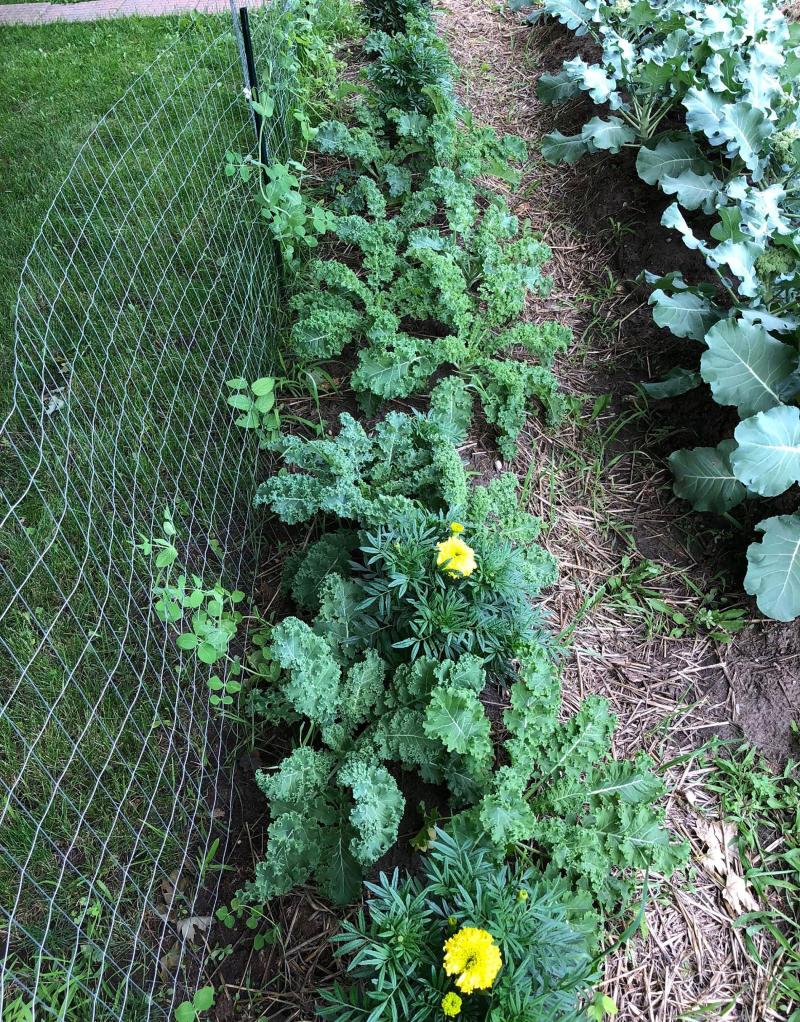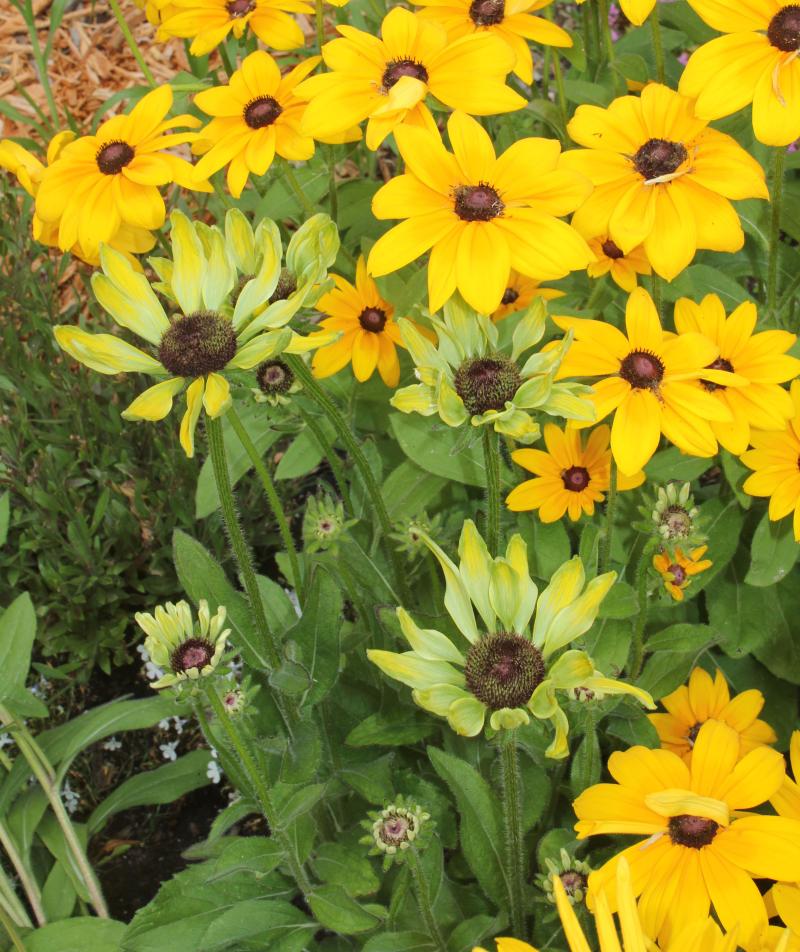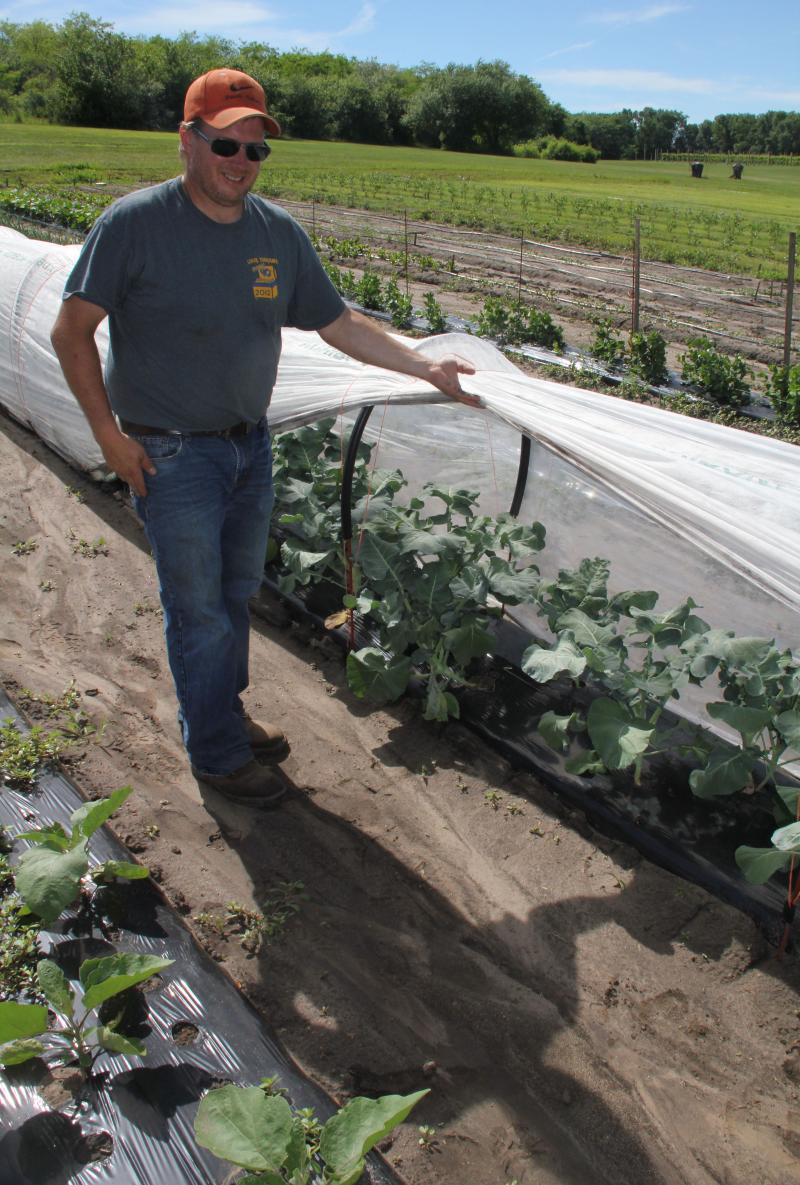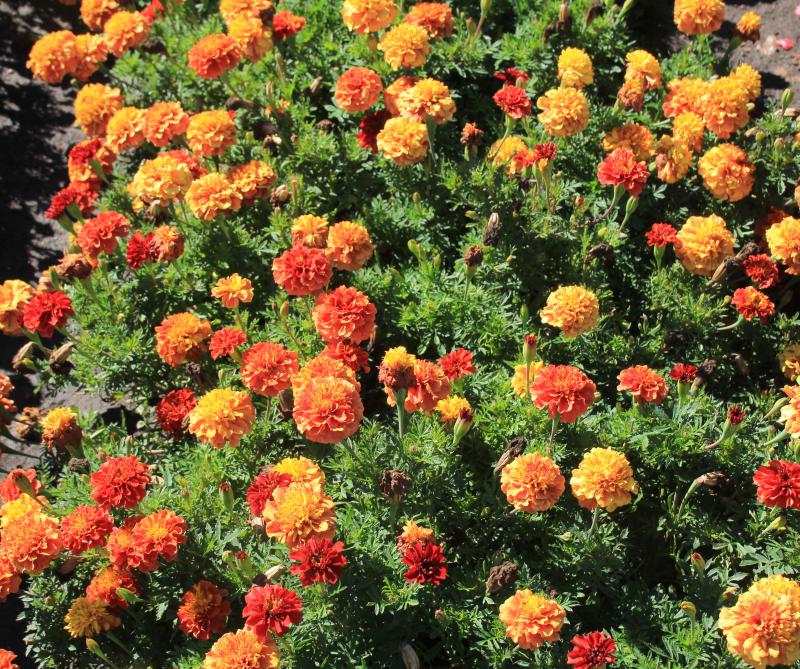Written by Wyatt Brown under the direction and review of Aimee Ladonski.
Throughout the previous column we discussed the importance of, and techniques available, for establishing fertile soil using organic methods. Healthy soils, which teem with microbes and incorporate a robust soil food web provide a complete nutrient profile and disease suppression mechanisms for our plants. This factor intrinsically provides a great start for controlling a wide variety of pests, as stress-free plants are extremely resilient to becoming sick. Plants are far more prone to disease and insect issues when growing conditions are not optimal. However, healthy soils alone are not the only weapons organic gardeners use to keep their plants thriving. In fact, many growers may notice small numbers of pests amongst their plants even when their soil is at peak performance. While healthy soil will certainly aid in minimalizing the threat of pests, certain factors throughout the growing season may still negatively affect our plants ability to defend themselves. Therefore, it is important for growers to possess an extensive arsenal at their disposal to combat Mother Nature’s constant barrage of environmental stressors to their crops.
Pest management is a broad subject, which on its own could sustain gardening columns for the entire summer! It is important for the sake of our readers to narrow it down to a broad overview of pest control tactics that allow growers to establish sanitary growing conditions in their gardens.
Integrated Pest Management
Integrated Pest Management (IPM) is an environmentally conscious approach to managing insects, weeds and disease. By focusing on natural processes, growers use pest control methods beginning with the least toxic and amplifying the pest control needs gradually if problems persist. The six steps of IPM include: 1.) Correct identification of damage and responsible pests. 2.) Know your pest and plant life cycle and biology. 3.) Monitor and sample for pest population. 4.) Establish acceptable damage threshold. 5.) Decide on appropriate management technique. 6.) Evaluate results. Of these six critical steps, deciding on a control method (appropriate management technique) for minimizing pest disturbance is key, and will be discussed in detail throughout this column. These control methods can be both preventative and reactive, and can be broken down into their own four tactical categories: Cultural, Mechanical & Physical, Biological, and Chemical. These tactical categories have been laid out purposely from least harmful to the environment, to most likely to cause damage to biological ecosystems.
Cultural Control

Cultural control methods are the oldest methods for controlling pests and they begin with how you as the grower conducts gardening business. Many professional horticulturists agree that cultural control methods are the most important for preventing plant disease. These methods are aimed at preventing and/or reducing insects, weeds and diseases before, during, and after your plants have been seeded or transplanted. Control methods in this category are numerous, covering areas like soil fertility management, companion planting, crop rotation, plant species selection, weeding, pruning methods and equipment sanitation to name a few. This entry in the column is in no way all-inclusive; cultural control methods range in the thousands depending on the grower’s environment, climate, soil type, and specific crop to name a few.
Start clean, keep it clean, finish clean should be your motto. Before or after a garden session, make sure your clothing and tools have been properly cleaned AND sanitized, especially if you are experiencing pest problems throughout your garden. For garden tools, rinse all mud and soil with a garden hose and allow to dry. Sanitation of tools is not possible unless the working surfaces are first clean of all debris. Growers have at their disposal a multitude of products available to them as ready-made solutions from gardening stores, or they can make their own for a fraction of the cost. The great thing about many commercial sanitizers is that they have proven to be less corrosive to metals than some of our homemade sprays. Lysol spray is a commercial product found in many homes and is a great way to kill pathogenic bacterial, fungal, and viral organisms. Homemade remedies including isopropyl alcohol (IPA), hydrogen peroxide or bleach solutions are a few of the more popular homemade concoctions for sanitizing tools. These ingredients can be used as a dip, or stored in a spray bottle for extended use. For bleach, users should dilute the solution to 1 part bleach to 9 parts water. Alcohol solutions have shown to be most effective in the 70% IPA to 30% water range. Each of these solutions should be applied to the working surface of the tool and allowed to sit or soak for 10 minutes.

Roguing is a term used to define the removal of dead, diseased, or infested plants from a growing area, and it is a must! Infestations of uncontrollable insects, fungus, bacteria, viruses, or phytoplasma like aster yellows should be considered for removal. Plants that are seriously ill will undoubtedly attract pests of all types to the area. As plants become excessively stressed, they send distress signals alerting other plants that they are under attack or dying. Coincidently, these signals are interpreted by insects and other pests as an invitation to the dinner table, and consequentially import an army of hungry feeders towards unsuspecting healthy plants. In severe cases saprophytes, microorganisms that feed and live on dead or decaying organic matter, begin to take over as the dying plants struggle to recover. Some of these saprophytes are facultative, which means they can feed on both dead and living plant material. Allowing dead plants to rot in your garden will provide a habitat for these organisms to multiple, putting your healthy plants at risk.
As technology and plant science progresses, so too do our options for plant varieties resistant to many environmental factors, insects and diseases. Selecting plant varieties that are suitable for your plant hardiness zone is a primary step in combatting disease. The majority of South Dakota is positioned within USDA plant hardiness zones 5A or colder. Attempting to grow plants that are not hardy to our climates will cause undue stress in many cases, unless you are growing in a controlled environment such as a greenhouse, indoors or within a high tunnel. This includes attempting to establish warm weather plants outside before the average last frost date. Furthermore, seed production companies which produce their seeds in climates similar to where you will be growing can help tremendously. Buying seeds from a regional company located in South Dakota or the Northern Plains would be much more suitable for our climate than a company producing seeds in the Southern regions of the United States. Additionally, thanks to the advances in plant breeding over the millennium, growers can purchase cultivars with built-in resistance to certain pests and diseases. Many seed catalogs will alert the purchaser to these types of resistance in the description of the plant. For example, a tomato cultivar that has shown resistance to Verticillium and Fusarium wilts will provide the letters VF after the cultivars name. Lastly, it is the buyer’s job to inspect mature plants before purchasing them from garden centers for planting in their home landscapes and gardens. Select healthy looking plants that are free of insects and disease, and buy certified disease-free plants and seeds from reputable sellers whenever possible. If in doubt, don’t buy it!
Mechanical and Physical Controls

Incorporating natural pest control measures into your growing scheme is a great start, but there are several man-made options at a grower’s disposal for keeping pests at bay. Mechanical & physical controls employ the use of physical objects or devices to control pests. These devices can include several different sizes, types and varieties of screens, barriers, fences, traps and mulches. This wide array of mechanisms can include deer fence, chicken wire, insect screens, bird nets, shade cloth, plastic mulch or other appropriate defense mechanisms to deter the infiltration of pests targeting your plants. Floating polyester row cover is a man-made product that provides defenses against several environmental stressors when properly utilized. The thin material allows rain water, sunlight, and gas exchange to permeate through to your crops, while preventing both the loss of heat and the infiltration of many insects and microbial pathogens. Physical controls may also involve the trapping and killing of pests around your growing areas. Garden stores provide an array of trapping options to include but not limited to sticky traps, colored traps, pheromone traps, trigger traps, light traps, and a variety of varmint traps designed to catch and/or kill small animals.
Biological Controls

Biological controls employ methods for controlling pests using other organisms, and have very few drawbacks compared to chemicals. Species variety amongst the landscape can provide many beneficial returns to our home ecosystem. Several predatory and beneficial insects are drawn to the home landscape when species abundance is prevalent. Fern-leaf yarrow (Achillea filipendulina) is an herbaceous perennial flower that is hardy to zones 3 to 9, and is a lovely addition to landscapes and borders of vegetable gardens. This crop is revered for its ability to attract several different species of predatory insects, to include Lacewings (Chrysopa spp.), Labybugs aka Ladybeetles (Hippodamia spp.), Hoverflies (Eupeodes spp.), and parasitic wasps to name a few. These predatory insects feed on, or lay eggs in, the insects that gorge on your plants, reducing their numbers exponentially. Preventative crops, such as the French and African varieties of marigolds (Tagetes spp.), secrete a root exudate into the soil that repels root feeding nematodes. The cultivar ‘Single Gold’ is sold as a highly effective preventative crop for this purpose.

Trap crops are a sacrificial crop used to attract insect pests to their locations instead of feeding on cash crops. There are two basic ways to use trap crops: same species and different species. An example of same species trap crops includes the use of Blue Hubbard Squash (Cucurbita maxima) as a sacrificial crop established around the perimeter of cucurbit cash crops to prevent the invasion of squash vine borer (Melittia cucurbitae). An example of different species trap crops includes the use of sunflowers (Helianthus annuus) to attract leaf-footed bugs (Leptoglossus spp.) away from your tomatoes.
Biological control agents of plant diseases are more often referred to as antagonists. Antagonists are beneficial microbes that inoculate plant surfaces through several methods. Soils that teem with a wide array of microbes can inoculate leaves and tissues as new emerging seedlings push through the soil. Growers may also apply antagonists as a foliar spray or soil drench from store-bought products. Bacillus subtilis is a naturally occurring bacterium found in soil and the gastrointestinal tracts of cattle and humans, and has shown great promise in controlling diseases like powdery mildew. These organisms are not harmful to humans, however some antagonists, such as the aizawai strain of Bacillus thuringiensis (Bt), have been shown to kill beneficial insects like bees. Conversely, B. thuringiensis var kurstaki is an important strain for combatting caterpillars and beetles. Growers are encouraged to use these products as a natural method for controlling pathogens, but should exercise due diligence towards the research of application methods and negative effects that may arise from their implementation.
Chemical Controls
Chemical controls are the last option when fighting pests. Chemical control options are varied in their application method and their capacity to alleviate pests. Be sure to follow label instructions for proper handling procedures and wear required personal protective equipment (PPE) when applying pesticides. While some concoctions can be used as a preventative applied to many plants, for use of chemicals like botanical poisons, it is imperative that the user applies these substances only to the affected plants, and in some instances, only to the part of the plant being affected. It is highly recommended for readers to either purchase a good organic gardening encyclopedia, or find reputable internet sources to reference for additional organic -icides as this list is too vast and ever-changing to catalog them all.
Some controls, like neem oil, provide eradication of pests from multiple kingdoms of organisms. When used as a spray, neem oil helps combat fungal diseases like powdery mildew, as well as more than 200 insect pests. Neem oil is an extract produced from the neem tree which is used over a broad spectrum of not only plant pest controls, but household items and medicinal applications as well. Food grade diatomaceous earth (DE) is another great multifaceted agent that provides numerous benefits to the garden and farm. DE is a powder shown to help keep slugs off plants, eliminate flies, control aphids, rid compost piles of maggots, discourage rodent attraction, increase porosity in potted plants, and provide a wide variety of positive health affects when incorporated with poultry and livestock for control of worms and parasites. DE is actually more of a mechanical control than a chemical control as its mode of operation is to slice open insect bodies, causing death by dehydration.
If all else fails, growers can apply a store-bought synthetic pesticide to combat their pests. Be sure to follow the instructions carefully as some of these chemicals can be highly toxic. Most will also have a post-harvest interval that indicates how many days to wait before the crop can again be harvested. It is recommended to follow synthetic applications with an organic application of “tea” a couple days following. Earthworm casting tea or compost tea, also known as actively aerated compost tea (AACT), are great inoculants for reestablishing plant microbiome health after a synthetic procedure. While not all synthetic products kill microbes, some are designed to do specifically that. It is because of this we must ensure we reestablish beneficial microbe populations immediately after our synthetic product has done its job. Tea concoction instructions will be focused on in subsequent columns, but readers can begin researching this topic from home through a simple internet search.


